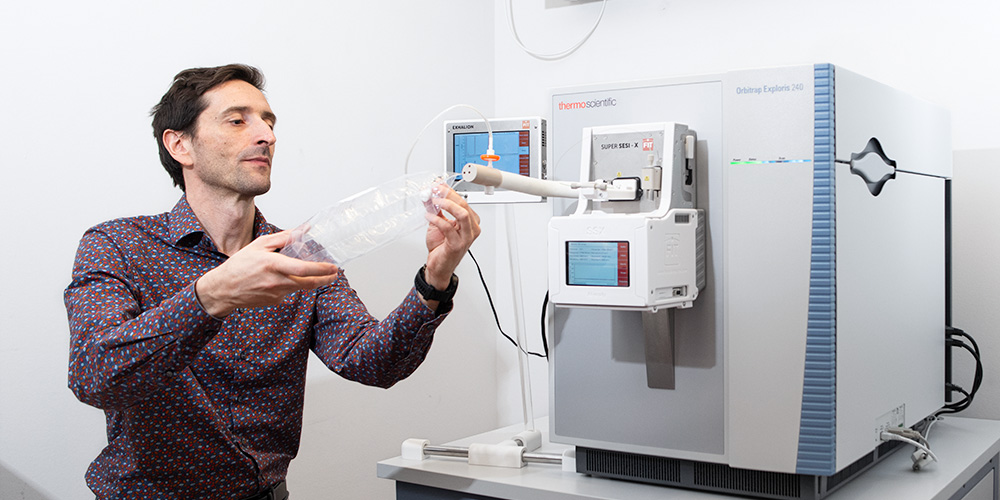Articel Content
Traces on breath.
Text: Andreas Lorenz-Meyer
The air that flows from our lungs contains information about the drugs we take. Pablo Sinues hopes to improve the treatment of epilepsy using breath tests.
Blood, urine and tissue samples contain clues about a person’s health. Yet in the future, medical professionals may be analyzing a new source of data – our breath. The air we exhale contains traces of volatile chemical compounds – metabolites – that are produced by the metabolic processes in our bodies. These compounds are a gaseous treasure trove of medical data, and Pablo Sinues from the Department of Biomedical Engineering at the University of Basel intends to track them down. Together with other researchers, he has developed a procedure to do just that. “Our breath analysis platform currently identifies around 400 different molecules and provides us with a person’s metabolic fingerprint,” explains Sinues.
Finding the right subject.
He first discovered this line of inquiry around 18 years ago while visiting Yale University in the U.S. during his doctoral research. His research led him to some unpublished papers authored by Yale professor John B. Fenn, winner of the 2002 Nobel Prize in Chemistry for his work on the analysis of large biological molecules. Based on Fenn’s research, Pablo Sinues developed a basic technique in which exhaled metabolites are first ionized, then detected and analyzed. Later on at ETH Zurich, Sinues refined this procedure to allow practitioners to monitor certain types of drugs, as these also produce trace metabolites that can be detected in exhaled air.
When Sinues took on a position at the University Children’s Hospital Basel (UKBB) in 2017, he found a group of subjects that could help him test his innovative method – young epilepsy patients. During epileptic seizures, neurons in the brain fire off abnormal electrical signals. Depending on which region of the cortex is affected, this might result in a full-body seizure or a momentary lapse in awareness. Epileptic conditions can often be treated using medications that reduce the excitability of nerve cells.
When Sinues joined UKBB, he noticed that epilepsy patients there were most often prescribed valproic acid (VPA). Valproic acid makes an excellent candidate for analysis because it is easy to detect in breath samples. So, he approached the Department of Neurology, which conducts regular monitoring of drug dosages for young epilepsy patients. This involves measuring the concentration of the drug in the body, generally by means of a blood test. Monitoring concentrations is key, because the dosage needs to be correct in order to achieve clinical objectives while minimizing side effects.
Tailwind for the breath test.
That was how the trials of the breath test began. Meanwhile, he has perfected this technique for epilepsy patients, and Sinues the researcher has also become Sinues the entrepreneur. Together with two partners, he founded the start-up Deep Breath Intelligence, which recently won the *zünder accelerator award, including a grant of CHF 15,000. In 2022, their first product, the DBI-EPIbreath® breath test, received its CE certification in compliance with the European In Vitro Diagnostic Medical Device Regulation (EU-IVDR), clearing it for sale within the EU and Switzerland. “We are already integrating our system in clinical practice at the UKBB and University Hospital Zurich,” says Sinues.
This is good news for those with epilepsy, as a blood test is no longer required to check drug levels and monitor dose. Instead, they simply blow softly into a mouthpiece, and the technology takes care of the rest. Their breath sample lands in a tiny ionization chamber where the various particles become electrically charged.
Afterwards, it is released into a large box, a mass spectrometer, that determines the mass of the charged molecules. Then a machine learning algorithm calculates the precise concentration of VPA. The detection limit is extremely low, at a scale of one part per trillion (ppt). “That’s like a single drop in 20 Olympic-sized swimming pools,” explains Sinues.
On site and in person.
The test is suitable even for small children. On top of that, it delivers results within ten minutes, so the VPA dose can be corrected immediately, if necessary. A blood test takes days, and by the time the results are in, the physician can no longer judge whether the dose is still accurate. Another key consideration is that about 90 percent of orally administered VPA binds to proteins in the bloodstream. Only a small fraction of the drug passes through the blood-brain barrier to reach the target site, the cortex. Yet the breath test is able to measure this key metric. Blood tests, conversely, measure the entire VPA concentration in the blood, which makes it difficult to predict the clinical effects of the medication.
Treating epilepsy is, however, not simply a matter of administering medication. Even when patients are taking the correct dose, some do not respond to the drug or experience side effects. For that reason, aside from measuring VPA, the test also detects other metabolites that may influence treatment, such as the products of tyrosine metabolism. Tyrosine is a precursor to neurotransmitters such as dopamine.
At the end of the process, the algorithm generates a risk value that points to additional indicators. “That allows neurologists to paint a more precise picture of the molecular landscape and improve treatments for patients,” says Sinues.
Next business case.
Plans for Deep Breath Intelligence go beyond producing tests for people with epilepsy. Their algorithm-supported analysis tool can help patients with other conditions, too. The team’s next goal is to bring a new procedure to market that detects worsening symptoms in patients with chronic respiratory diseases. A breath test could bring more certainty to the diagnostic process because breath samples from patients with these conditions contain traces of metabolites associated with respiratory disease. According to Sinues, the data are very promising. This second breath test procedure may be available in three to five years.
More articles in this issue of UNI NOVA (May 2024).
